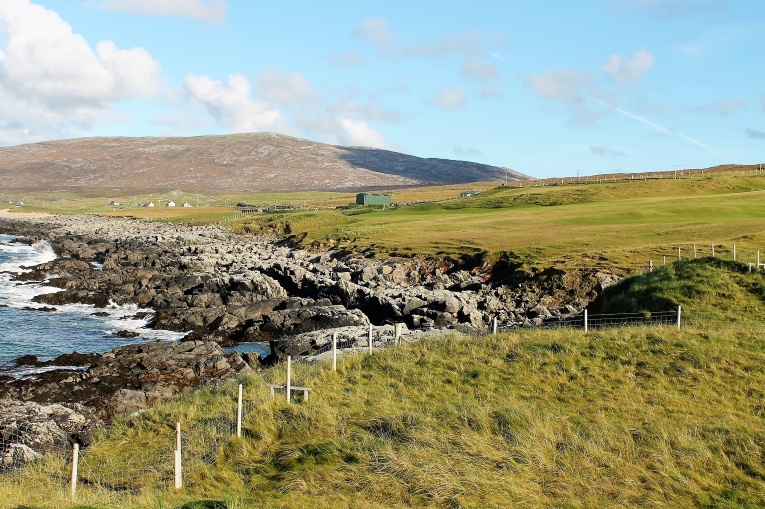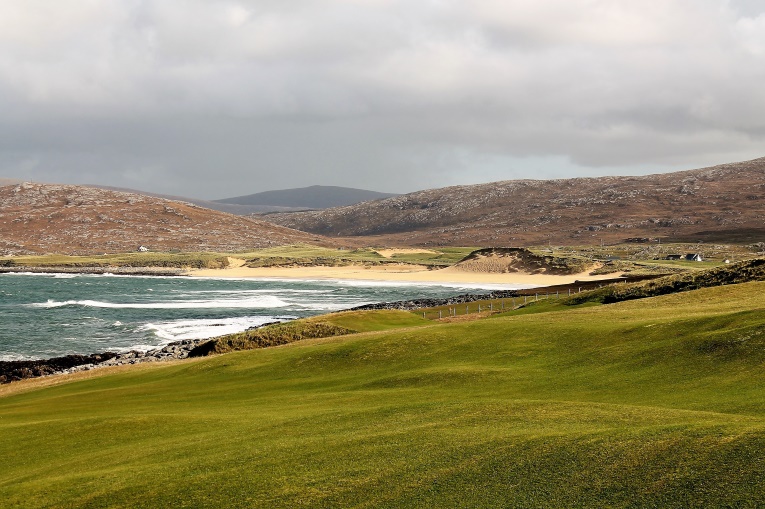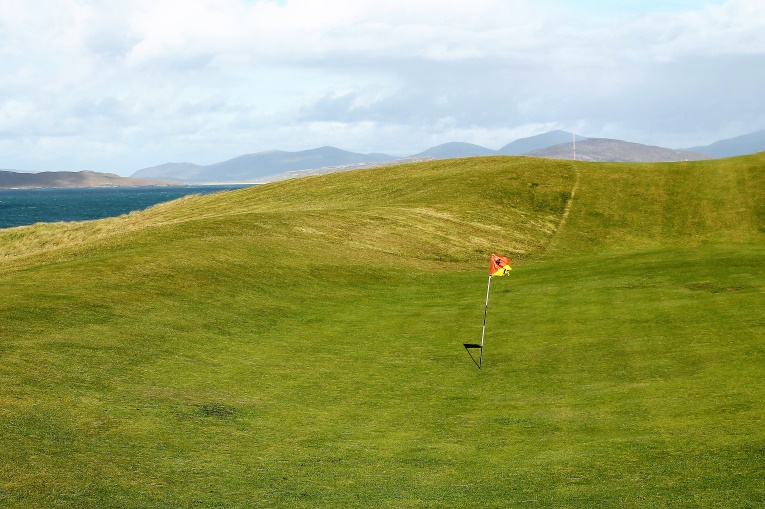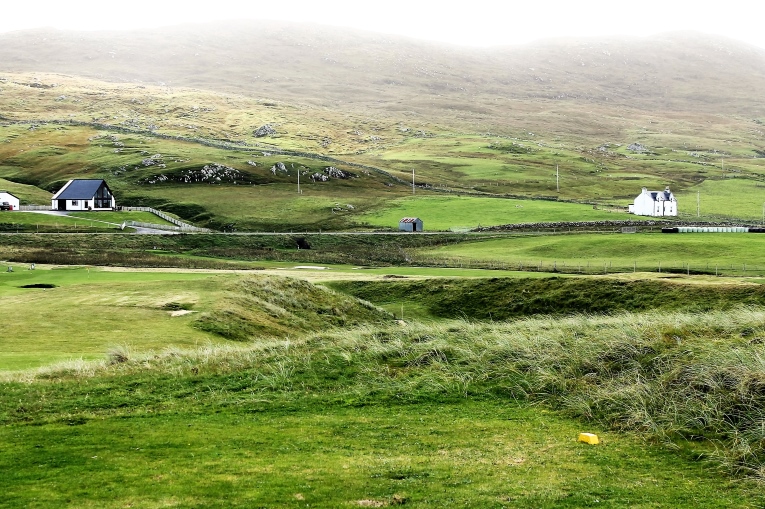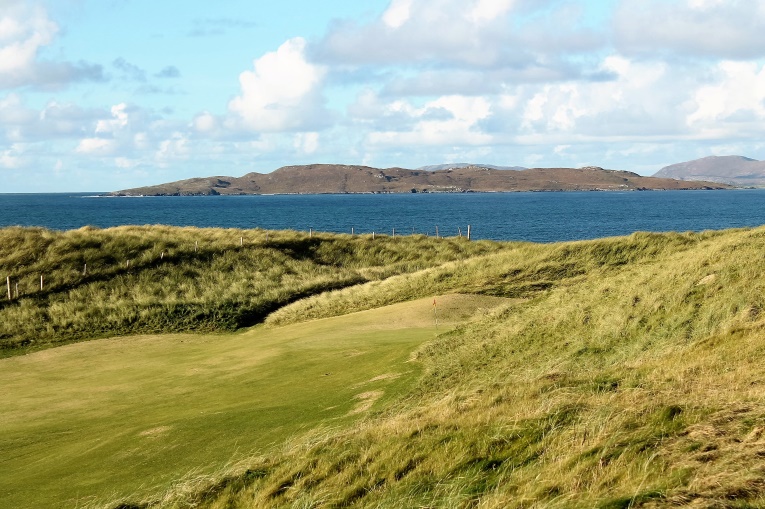The Isle of Harris Golf Club
Scarista, Outer Hebrides, Scotland
United Kingdom

A game at the Isle of Harris Golf Club embraces the most laudable virtues of this ancient sport without the muss, fuss and expense that mars the modern game.
Man should not be without golf. That happy sentiment was held by the locals who built nine holes here around 1920. They had the permission of Lord Leverhume (William Hesketh Lever), who had purchased the isles of Harris and Lewis in the early 1900s. This English politician and philanthropist played one of the first recorded games at Scarista in the early 1920s. (The name ‘Lever’ ultimately became known world-wide as the world’s first multinational corporation, Unilever). G.G. MacDonald was the first documented champion of a club event here in 1939.
At 2,454 yards, this par 34 nine holer isn’t the Muhammad Ali of golf but rather Floyd Mayweather as it packs quite a punch for its size. A majority of the two shot holes (i.e. the 1st, 3rd, 5th, and 9th) either drop or ascend more than forty feet from tee to green over the rambunctious terrain of the rock-strewn island. Incomparable views are regularly appreciated north along the craggy shoreline and south across the expansive Scarista beach to the distant Ciababhal mountains on Toehead peninsula. No course in the world trumps it for raw beauty – the unspoiled environment is that mesmerizing.
Two things stand out regarding the golf: First, how well and how varied the land is utilized and second, how much fun the greens create as a set of targets. It’s a pity that more isn’t known about who deserves credit for it as there are some appealingly fresh design attributes. As for the routing, drama is the only common denominator. Holes plunge downhill (e.g. the 1st, 5th, 8th), climb uphill abruptly (e.g. the 3rd), sometimes gradually (e.g. the 9th), twist through dunes (e.g. the 6th), over dunes (e.g. the 4th), or play sidehill (e.g. the 2nd, 7th). Beat that for variety!
In regards to the green complexes, they don’t let this special property down. A majority of them (e.g. the 1st, 2nd, 3rd, 4th and 9th) feature tightly mown side banks that range upward to six feet. Figuring out how and when to use the banks in the various winds is at the heart of the challenge/fun. Look at the second green below – wouldn’t your heart be lifted by the sight of a perfectly judged approach where the ball feeds off the high right, swooshes across the green, banks right, and settles near the back hole location – Pure magic! The others also engender creative challenge. For example, the sixth is one third (!) the size of the Postage Stamp, the seventh is Green Keeper James Dunne’s favorite and the eighth falls away from the golfer.

The bank along the left was built to help shelter the putting surface and enable good grass coverage. Though small, the fronting bunker plays large as all the high ground to the right funnels balls into it.
Great bunkering is the missing ingredient because the windy locale doesn’t lend itself to having sand particles stay stationary and loiter politely in a defined hazard. Indeed, only twelve bunkers dot the course and they are smallish. Similar to Royal Ashdown Forest, a lack of bunkers doesn’t diminish the playing experience but merely alters it. A round here is a novel playing experience, one that even the most jaded traveler is bound to savor long after his X rounds on mundane parkland courses blur.
The charm begins right away in the club’s diminutive parking lot, which can accommodate ~20 vehicles. Pulling in, you enjoy an uninterrupted 270 degree view across much of the course. What’s missing is … a clubhouse or for that matter any man-made artifice other than the fence and signage for the first tee. Splendidly done, the clubhouse is constructed of several shipping containers sunk into the hillside. Doing so was the brainchild of past captain Willie Fulton. From the early 1990s into this century, Fulton also helped drive a dramatic improvement in course conditioning, moving the course away from what was then described locally as ‘a patch of grazing land.’ As you open the gate and enter club property, you pass the honor box and step onto the first tee which virtually sits on top of the clubhouse. Indeed, the elemental glory of the Outer Hebrides in general and the Isle of Harris in particular is presented in an invigoratingly unfettered manner.

The clubhouse is out of sight, shrewdly sunk into the hillside. With no benches or ball washers, the course is free of clutter and the sense of man vs nature is exacerbated.
Golf is supposed to be a simple sport, one that adds joy to life and doesn’t complicate it. That basic allure of the sport is celebrated here in spades, as we see below.
Holes to Note
First hole, 260 yards, Borve; The exhilarating view from the first tee of the green below, near the water’s edge leaves no doubt that this is going to be a rollicking round. More times than not, the wind is left to right across the hole conspiring with the mound short right of the angled green to befuddle the complacent golfer. Conversely, everything can go your way: a hole-in-one was registered here in 2016, a cracking fine start to a round indeed. The mighty blow was struck by past Captain Hugh MacLean and even better, it was the inaugural shot of this playing season!

Set at an angle to the fairway, the first green is defended by the mound in front, another behind, and the angle of the putting surface to the fairway.
Second hole, 300 yards, Scarista; On the Isle of Harris, this is the hole the course is most famous for. And why not? It has everything: the tee ball plays on a diagonal across the rocky shoreline to a humpy-bumpy fairway before ending at a fascinating green complex. Much like the course, if the hole was 30% longer, it would be a household name far and wide.
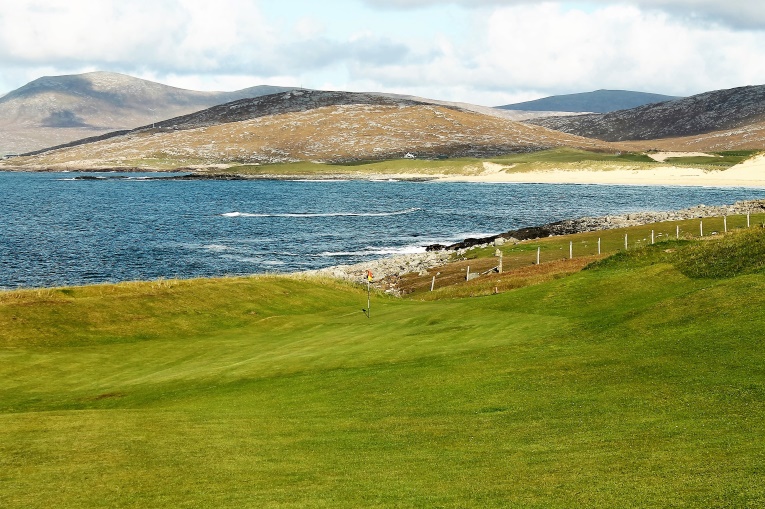
The ground game rules on the approach but not in a typical links way. Instead, it’s the golfer who best utilizes the side banks who will triumph.

The rear of the green is eight paces across but the actual area for hole locations is a mere 25% of that (i.e. two paces across in the flat part of the trough).

Looking back down the second fairway to the defiant tee perched high on rocks that jut into the sea. The next stop west is Newfoundland!
Third hole, 310 yards, St. Kilda; This is a hole of two parts. The first is dispiriting – the golfer on the tee is confronted by a seemingly endless steep uphill slope. In actuality, at the 160 yard mark, the fairway stair-steps down ten feet before swinging left and climbing farther up the hill. The approach is to another one of Scarista’s appealing saddle greens.
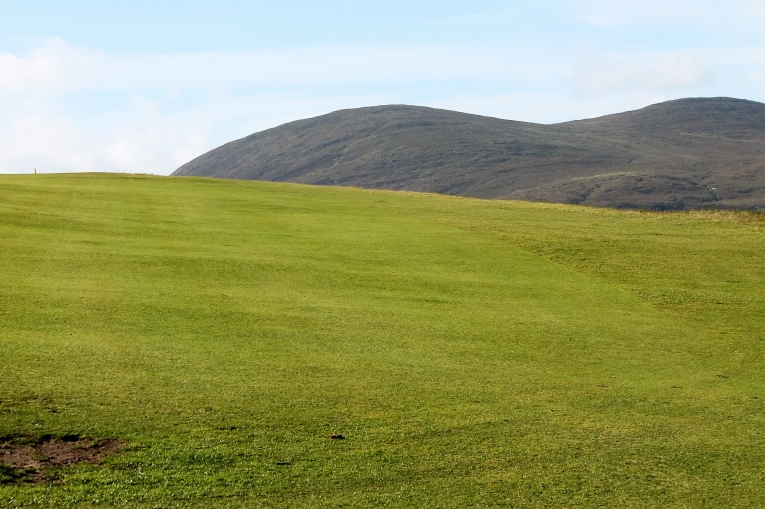
The view from the third tee is daunting as the fairway rises at an abrupt 40 degree angle. Generally played into the wind, the fairway actually provides shelter to a well executed, boring tee ball. The Ciababhal mountains well in the distance provide a handsome backdrop.
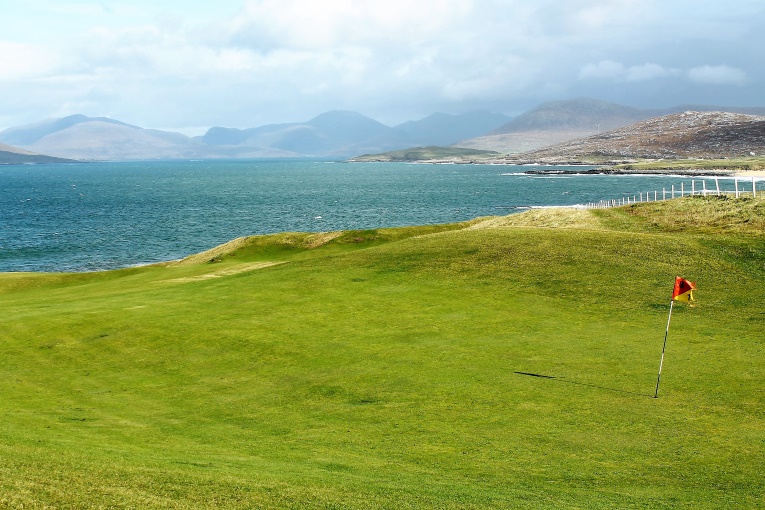
What a start! The first three holes complete a triangle in which the golfer descends fifty feet to the shoreline, traverses the coast and returns uphill.
Fourth hole, 145 yards, Ensay; The fourth crisscrosses the first hole to … where?! A directional marker at the crest of the hill provides a clue but directional markers and one shotters rarely go together. For a sense of adventure, one of the few courses in the world that can rival this one is found – not surprisingly – 65 miles to the south on the Isle of South Ulst – Askernish Golf Club. Both clubs have a small green keeping staff. At Askernish four people look after eighteen holes and here it is the head Green Keeper James Dunne. That’s right, one man, who enlists help from the locals as required. Dunne had worked at several golf clubs on the mainland of the United Kingdom (including a stint at Walton Heath) before moving to the Outer Hebrides in 2012. As you can see, he does an outstanding job of maximizing the available resources. Additionally, he enjoys a keen sense of what constitutes good golf and he keeps the heavy beach grasses well back from play.

Only once the golfer is within 50 yards of the green does the vista of the bunkerless punchbowl green and the stunning Scarista beach greet the golfer. This beach continues as Northton beach creating a wondrous panorama of land, sea and sky. (Traigh Sgarastaigh in Gaelic) adds to the enchantment of being here.
Fifth hole, 350 yards, Langavat; Someone who knew what they were doing routed this hole. The rumpled fairway feints left before jogging right and crossing an attractive burn to a green set at the property’s low point. Pure sand becomes loamy in this southeast corner pocket but the course is quick to drain nonetheless. In fact, visitors are surprised to learn that the locals are quick to avail themselves of playing the course during the winter months when the weather permits. Watching one’s tee ball at the fifth pitch and tumble as it scoots down the hill is a highly satisfying ‘quiet’ moment.

A tee ball that squeezes past the distant burn is ideal. As seen above, the right side of the hole has been cut for the season but it is the one area on the course where Dunne lets tall grass encroach to discourage people from being too greedy off the tee.
Sixth hole, 220 yards, Toe Head; Designated a par four, this is the shortest two-shotter the author has yet encountered and a supreme example of how meaningless yardage is in this environment. On the late September day the author played, a ‘Weather Disruption Alert’ was in effect for wind gusts up to 70 mph and the sixth played dead into it, seemingly adding ~50% to its uphill length. Even in still conditions the hole would be fascinating, thanks to its green – the tiniest the author has ever seen. Only 9 by 11 paces, the oval putting surface measures less than 1,000 square feet. While both the hole’s distance and green are miniscule, the two play off each other perfectly and the hole – shockingly – possesses intriguing playing angles.

This view from near the tee offers a glimpse of the yellow and red flag above the right dune. Just right of the flag are …

… two hidden bunkers 40 yards shy of the green and a small pit that fronts the green on the direct line from the tee. Trial and error suggests there is wisdom in playing short left of the green and tacking in from there.

Occasional attempts have been made to expand the putting surface but all such efforts appeared artificial. The green simply wants to occupy the shallow ~800 square foot dish and nothing more. A player once took 16 (!) shots to get out of the small pit in front of the green and was awarded a special accommodation for perseverance at the club’s annual prize giving.
Seventh hole, 160 yards, Pabbay; Contestants flock in from all over the United Kingdom (and even a few from the States) to compete for the Isle of Harris Open. Needless to say, the winner gets not a green jacket but a tweed one. Credit for the event goes to the aforementioned Hugh MacLean, who followed Willie Fulton as captain of the club. The jam-packed tournament’s proceeds are plowed back into the course and have helped Scarista gain the professional footing that it now enjoys. Dunne describes how a contestant in a recent Open hit the green in regulation, putted from the back left corner toward a front right hole location, watched in dismay as his putt found the front right bunker and ultimately carded an 11. He was a fine player too and the mishap cost him a realistic chance at the coveted tweed jacket. Of the three one-shotters, it is worth noting that they all head in different directions. That fact wouldn’t matter on a calm inland course but here, it does!
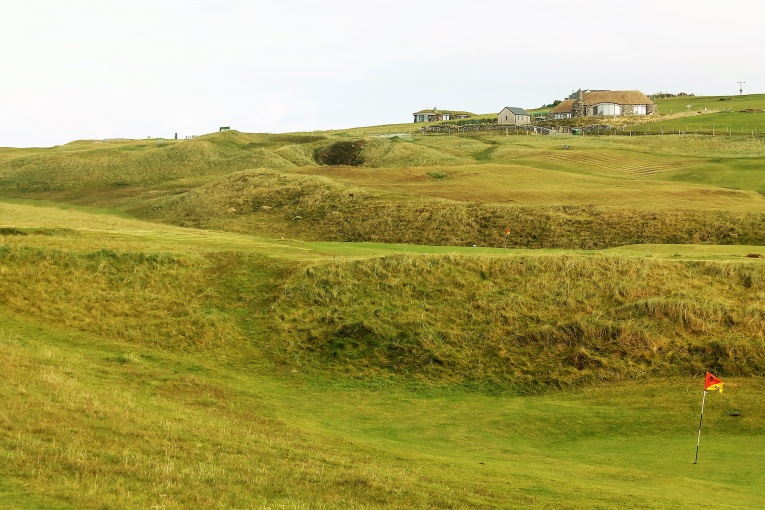
The seventh plays across the sixth green to a green that follows the natural grade of the land (i.e. it is canted from high back left to low front right). It’s Dunne’s favorite putting surface as it affords more interesting hole locations than any other green.
Eighth hole, 220 yards, Taransay; This stout one shotter’s dominant feature is a fifteen foot hollow along the right. To land there is deplorable but carry it and there is a good chance that your tee ball will take the downslope and trundle onto the open putting ground. The author especially relishes shots that take time to play out; this is one such and the elevated tee provides a fine vantage point for watching events unfold.
Ninth hole, 495 yards, Killegray; The sole three-shotter provides a fitting conclusion. Highlights include the central bunker some 80 yards short of the green and a green complex set at an angle to the fairway. Maintaining acceptable grass coverage on the green is a constant struggle given the ever-shifting sands. Dunne’s efforts are both noble and eminent because the green, snuggled between two dunes and set at an angle to the fairway, is superlative and worth fighting for.
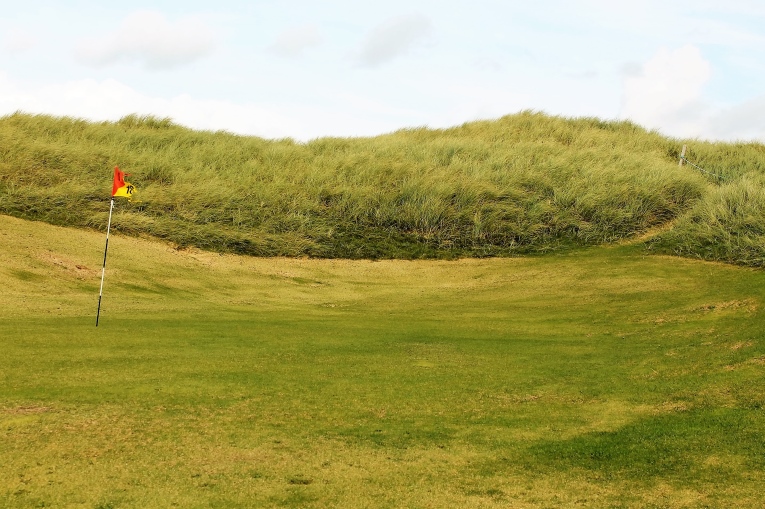
Give Dunne and the club credit for preserving this green complex and maintaining suitable grass coverage.
To the author, the course is wonderful ‘as is.’ Some look at its scorecard at www.harrisgolf.com and dismiss it is a rudimentary course, too short to hold their interest. Mistake! Regardless, the club is not opposed to extending a few holes where distance can be beneficial. An example is a potential new first green that would be even closer to the shoreline than today’s. Sod is price prohibitive and grow-ins are reluctant in this part of the world so Dunne hopes that the new green will be in play in 2018.
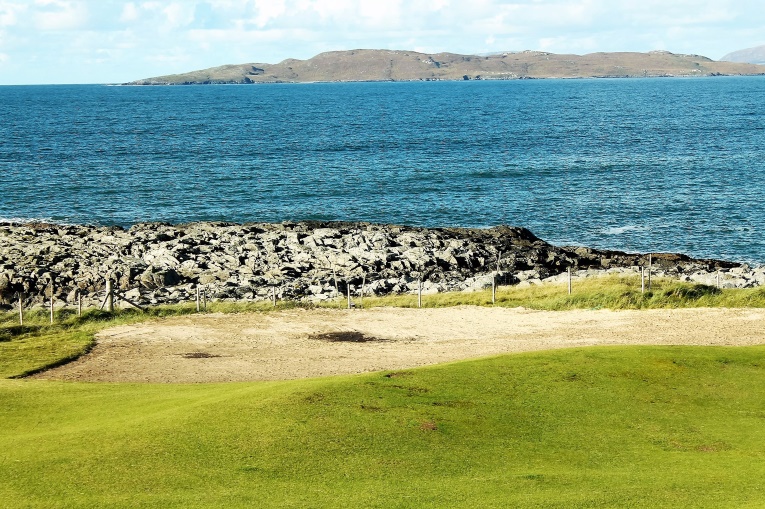
Mastering how to use the knob in front of what will become the new first green will be crucial. The new green brings an additional 20 yards to the hole and makes driving the green less likely.
If you go around twice you will have played a course that measures just under 5,000 yards. More importantly, you will enjoy many breathtaking moments and a slew of exhilarating golf holes. With 1,500 rounds a year, you are likely to enjoy the course in blissful isolation. Superb accommodations are nearby and include Rock House at Borve Lodge and Scarista House (which is well known for their nightly culinary efforts).

For those that yearn for simpler times, staying at the Rock House and playing the Isle of Harris Golf Club are a superb one-two punch.
After our round, we climbed into the car and enjoyed a moment of rapturous silence. Then, looking out over the course, I wistfully remarked to my newlywed, ‘How soon do you think we can return?’ No other sentiment matters more – the allure of the Isle of Harris and its authentic brand of golf far surpasses the artificial, dolled up version found in most other countries.

This photograph taken two miles to the north of the course highlights the hues and textures that serve as the inspiration for the island’s most famous export – Harris Tweed.


